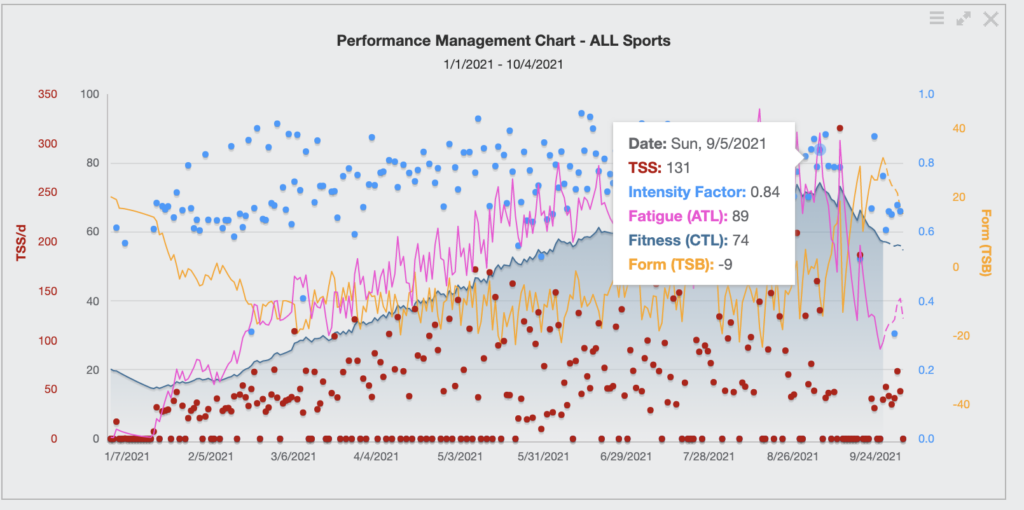While many endurance athletes are active learners who become competent from doing, there’s a great amount of knowledge to be gained from a bit of reflection. At this time of year, a post-season analysis can help your racing lessons stick, and, when done well, can create a roadmap for the season ahead.
Research has concluded that post-performance reflection and analysis has many benefits, including:
- Increase in self-confidence
- Change in subsequent training/preparation behavior that promotes ongoing goal achievement
- Improvement in preparation and execution leading into an event (setting an athlete up for optimal performance)
- Increased self-awareness (which can support game-day decision making)
- Skill development
- Establishment of a framework for future goal setting
Additionally, a post-season analysis is an excellent starting place for the following season, as it connects your current season achievements with those you hope to pursue in the future. It is also a good way to confirm that the goals you set are those that still matter to you.
The key elements of a post-season analysis include an assessment of:
- Goals and achievements
- Race outcomes and execution
- Training metrics
- Holistic reflection
The following is a guide to conducting your own post-season review. This analysis will take some time, and is best completed over a series of days or a week. Don’t rush it! It will be the cornerstone for your upcoming season.
Reflect on Your Previous Goals and Achievements
Return to the goals you set at the beginning of this year and reflect on the following questions:
- Which goals did you achieve and which remain for the future?
- What were the challenges you faced as you worked toward your goals?
- Why were you successful in meeting your goals?
Goals are the focal point of your annual training plan and allow you to celebrate the key wins for your year. Go beyond simply checking the box for whether or not a goal is achieved to consider why you were or weren’t successful. You can then take those learnings to help set you up for success in the coming season.
Analyze Your Race Performance
Begin your race analysis using the TrainingPeaks race report chart, which you can review in your dashboard. Log your overall time, segment time (for multi-sport or stage events), and describe details about your placement. The results tab in TrainingPeaks events allows you to log placement for division, gender, and overall — I recommend keeping track of all three. Then, over time, you can review how both your times and your placement progresses.
In addition to the outcomes, assess your execution over the course of the season. Holistically, what did you do well when executing your race day game plan? What needs improvement? Re-read your reflections from each race and learn from the patterns. Look to both your narrative of these races as well as the metrics. I’ve written previously about how to do a post-race analysis, which you can find here.
For example, do you start off too hard and fade or do you remain strong throughout most races? Did you have any GI issues that may speak to a need to adjust your fueling and hydration strategy? Do you find that certain types of weather have a positive or negative impact on your performance? These are just a few examples to consider. Your experience is likely to vary.
More broadly, did you set up your race calendar for success? For example, was the timing of your races well-spaced to help you hit your goals for a PR or a podium placement? Did you select races that work well with the rhythm and schedule of your work and family life? If not, what timing would have been better? Did you feel like you needed more or less preperatory races prior to your key race(s) of the season?
Remember that races and goals are not one and the same. Races are events during which we may seek to achieve certain goals. By separating goals from races, we can continue to pursue our goals regardless of any one race’s outcome. In this manner, if you miss the goal at one race, that’s okay because there are always future races!
Review Your Training Metrics
Equally valuable to race assessment is a review of your training, which can include an assessment of your fitness, consistency, and skills development.
Fitness: PMC, CTL, and TSS
When I review an athlete’s metrics for the season to determine fitness and consistency, I start with the Performance Management Chart (PMC). You want to see a gradual growth in your chronic training load (CTL), which reflects the growth of your Fitness throughout the season. If your CTL did not rise gradually and consistently, what were the challenges that prevented this?
From here, determine your peak CTL, which you can see by hovering over the peak CTL in your PMC as seen in the image below. Peak CTL provides insight as to how far you were able to take your training load in a given season and how far you may be able to go in the future. Peak CTL can also be used to determine if you built an adequate training load to support your goals.

You may also consider the peak low points in your Training Stress Balance or Form, as noted in the PMC. For example, if you notice that every time your TSB drops below -25 or -30 you get sick or feel like you can’t recover properly, you may note that as the absolute floor in how low you want that number to go in the future.
Beyond the PMC, there are TSS charts that help you determine your peak weekly TSS, and average weekly TSS. See images below.
Add to this information your average weekly training volume, and your total hours of training for the season. Again, this information is easily ascertained from charts.
Once you have this information, you can assess if you hit your training goals as laid out in your training plan or ATP. You can also use these numbers to determine targets for next year, keeping increases within 10% to reduce injury risk and burnout.
Consistency
Once you’ve got a sense of your overall fitness load, move on to assess your overall training consistency. A gradually rising CTL speaks to solid consistency.
The fitness summary chart is another tool to help you ascertain your overall consistency. It will break out what you completed, and when you hover your mouse over any segment, you can see how much you completed versus planned, as shown in the image below:
In addition to assessing your consistency, consider your intensity discipline. Intensity discipline refers to the degree to which you stick with the targets prescribed in any given workout. A common mistake is to push easy or aerobic days too hard, which in turn makes it more difficult to appropriately hit the hard efforts. If you find that you lack intensity discipline, consider why and make a plan to address that for the coming season.
Gains
Take the time to identify your key gains from the season. Charts that work great for this purpose include:
- Peak Pace or Power: Review your peak pacing or power for the time period you select. You can also make comparisons across two different time periods, such as the first half compared to the second half of the year, or this season compared to last season.
- Fitness History: This chart offers you the option to review fitness progression each month (up to 12 months) for heart rate, power, cadence, speed, pace, or pace by distance. As you see in the image below, you can select by sport and then what variable you want to compare.
- Duration Charts: Use these charts — set by sport — to determine what your longest sessions were. This can be helpful if you are trying to determine if you have the experience and foundation to increase to a new distance.
Subjective Assessments
Not all training gains can be measured by metrics. But, subjective improvements are just as important! For example, did you improve your bike handling skills? Did you become more comfortable running on technical trails? Did you improve your fueling and hydration? Insert your accomplishments here!
For these assessments, review your training log comments or consider the skills you developed to get a sense of the overall trajectory of your growth.
Conduct a Holistic Reflection
As you reflect on the totality of your season, consider the following:
- What are you most proud of?
- What are your key achievements?
- What was the most fun for you this year?
- What do you wish went better? Of those things, what was in your control and what wasn’t? How can you better control the controllables? What can you do to better control your response and attitude toward things that are out of your control?
Throughout the analysis, celebrate your accomplishments. Take note of your areas of opportunity so you can continue to work on those in the new season. Use this information in the dreaming season to come. And, most importantly, be grateful for your past race season — we are so lucky to be able to live this endurance lifestyle!
References
Francis, J. & Jones, G. (2014, April). Elite Rugby Union Players Perceptions of Performance Analysis. Retrieved from https://www.researchgate.net/publication/261297336_Elite_Rugby_Union_Players_Perceptions_of_Performance_Analysis
Gomez-Ruano, M.A. et al. (2020, October 30). Editorial: Performance Analysis in Sport. Retrieved from https://www.frontiersin.org/articles/10.3389/fpsyg.2020.611634/full
Groom, R. et al. (2011, January). The Delivery of Video-Based Performance Analysis by England Youth Soccer Coaches: Towards a Grounded Theory. Retrieved from https://www.researchgate.net/publication/48227717_The_Delivery_of_Video-Based_Performance_Analysis_by_England_Youth_Soccer_Coaches_Towards_a_Grounded_Theory
Luiselli, J.K. et al. (2011). Review of sports performance research with youth, collegiate and elite athletes. Retrieved from https://www.ncbi.nlm.nih.gov/pmc/articles/PMC3251306/










